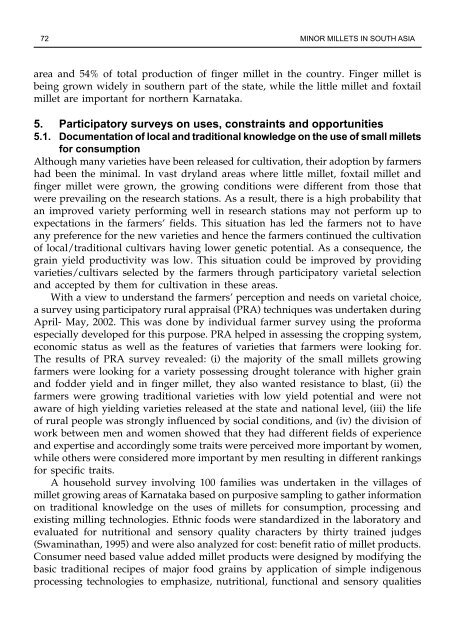Minor millets in South Asia: learnings from IFAD-NUS project in India ...
Minor millets in South Asia: learnings from IFAD-NUS project in India ...
Minor millets in South Asia: learnings from IFAD-NUS project in India ...
You also want an ePaper? Increase the reach of your titles
YUMPU automatically turns print PDFs into web optimized ePapers that Google loves.
72 m<strong>in</strong>or <strong>millets</strong> <strong>in</strong> south asia<br />
area and 54% of total production of f<strong>in</strong>ger millet <strong>in</strong> the country. F<strong>in</strong>ger millet is<br />
be<strong>in</strong>g grown widely <strong>in</strong> southern part of the state, while the little millet and foxtail<br />
millet are important for northern Karnataka.<br />
5. Participatory surveys on uses, constra<strong>in</strong>ts and opportunities<br />
5.1. Documentation of local and traditional knowledge on the use of small <strong>millets</strong><br />
for consumption<br />
Although many varieties have been released for cultivation, their adoption by farmers<br />
had been the m<strong>in</strong>imal. In vast dryland areas where little millet, foxtail millet and<br />
f<strong>in</strong>ger millet were grown, the grow<strong>in</strong>g conditions were different <strong>from</strong> those that<br />
were prevail<strong>in</strong>g on the research stations. As a result, there is a high probability that<br />
an improved variety perform<strong>in</strong>g well <strong>in</strong> research stations may not perform up to<br />
expectations <strong>in</strong> the farmers’ fields. This situation has led the farmers not to have<br />
any preference for the new varieties and hence the farmers cont<strong>in</strong>ued the cultivation<br />
of local/traditional cultivars hav<strong>in</strong>g lower genetic potential. As a consequence, the<br />
gra<strong>in</strong> yield productivity was low. This situation could be improved by provid<strong>in</strong>g<br />
varieties/cultivars selected by the farmers through participatory varietal selection<br />
and accepted by them for cultivation <strong>in</strong> these areas.<br />
With a view to understand the farmers’ perception and needs on varietal choice,<br />
a survey us<strong>in</strong>g participatory rural appraisal (PRA) techniques was undertaken dur<strong>in</strong>g<br />
April- May, 2002. This was done by <strong>in</strong>dividual farmer survey us<strong>in</strong>g the proforma<br />
especially developed for this purpose. PRA helped <strong>in</strong> assess<strong>in</strong>g the cropp<strong>in</strong>g system,<br />
economic status as well as the features of varieties that farmers were look<strong>in</strong>g for.<br />
The results of PRA survey revealed: (i) the majority of the small <strong>millets</strong> grow<strong>in</strong>g<br />
farmers were look<strong>in</strong>g for a variety possess<strong>in</strong>g drought tolerance with higher gra<strong>in</strong><br />
and fodder yield and <strong>in</strong> f<strong>in</strong>ger millet, they also wanted resistance to blast, (ii) the<br />
farmers were grow<strong>in</strong>g traditional varieties with low yield potential and were not<br />
aware of high yield<strong>in</strong>g varieties released at the state and national level, (iii) the life<br />
of rural people was strongly <strong>in</strong>fluenced by social conditions, and (iv) the division of<br />
work between men and women showed that they had different fields of experience<br />
and expertise and accord<strong>in</strong>gly some traits were perceived more important by women,<br />
while others were considered more important by men result<strong>in</strong>g <strong>in</strong> different rank<strong>in</strong>gs<br />
for specific traits.<br />
A household survey <strong>in</strong>volv<strong>in</strong>g 100 families was undertaken <strong>in</strong> the villages of<br />
millet grow<strong>in</strong>g areas of Karnataka based on purposive sampl<strong>in</strong>g to gather <strong>in</strong>formation<br />
on traditional knowledge on the uses of <strong>millets</strong> for consumption, process<strong>in</strong>g and<br />
exist<strong>in</strong>g mill<strong>in</strong>g technologies. Ethnic foods were standardized <strong>in</strong> the laboratory and<br />
evaluated for nutritional and sensory quality characters by thirty tra<strong>in</strong>ed judges<br />
(Swam<strong>in</strong>athan, 1995) and were also analyzed for cost: benefit ratio of millet products.<br />
Consumer need based value added millet products were designed by modify<strong>in</strong>g the<br />
basic traditional recipes of major food gra<strong>in</strong>s by application of simple <strong>in</strong>digenous<br />
process<strong>in</strong>g technologies to emphasize, nutritional, functional and sensory qualities

















